Today sales of desktop processors Intel Core Ultra 200S, as well as motherboards with an LGA 1851 socket, began. Profile media published the first independent reviews of new products. Brief conclusions confirm the words of Intel itself and rumors: the gaming performance of the new chips is lower than that of their predecessors, not to mention their competitors. However, the new Intel processors consume almost half as much power in games as the excessively power-hungry 14th generation Cores.
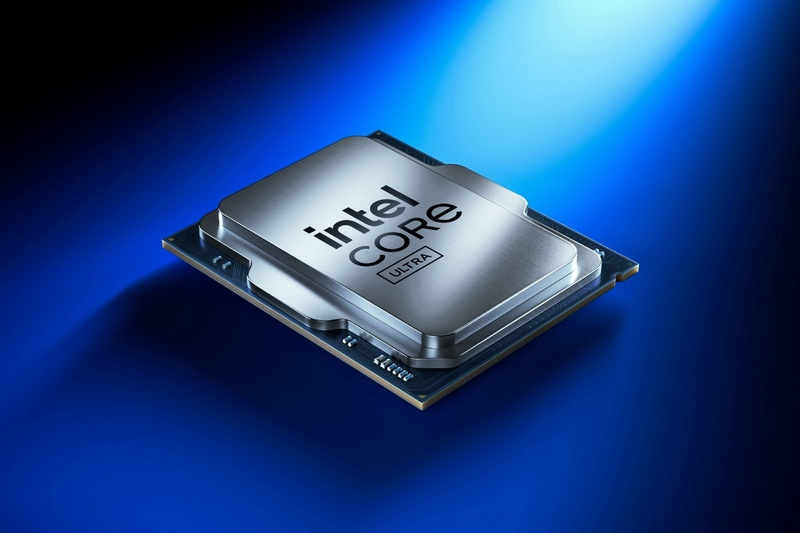
Image Source: Intel
Before diving directly into the results of testing the work and gaming performance of Core Ultra 200S processors, let’s briefly recall the key features of the new chips, codenamed Arrow Lake-S.
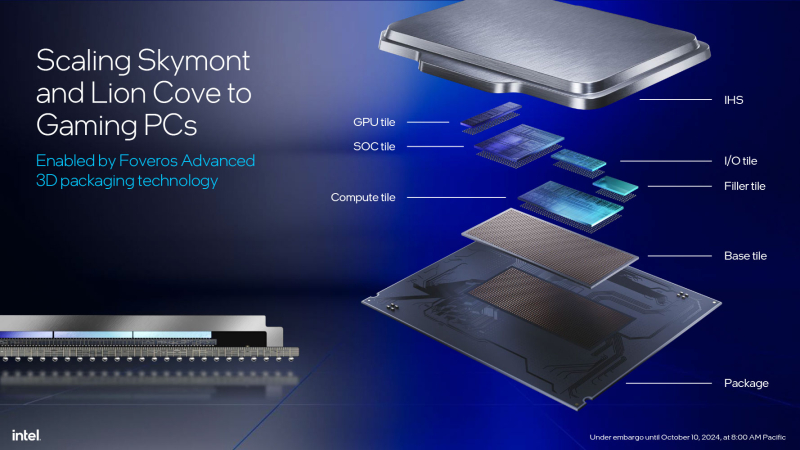
Intel Core Ultra 200S, for the first time for consumer desktop processors, Intel does not use a monolithic crystal design, but consists of four chiplets: a CPU computing unit, manufactured using the TSMC N3B 3-nm process technology and containing new P-cores Lion Cove and E-cores Skymont, and also cache memory; SoC chiplet, which is manufactured using TSMC N6 6nm process technology and contains a media engine, memory controller, etc.; integrated graphics processor (iGPU) chiplet based on the first generation Xe LPG architecture with four Xe cores and 512 stream processors, which is manufactured using TSMC N5 5nm process technology; and finally, the input/output interface chiplet (I/O Die), which is manufactured on the TSMC N6 6nm process technology, provides support for 20 PCIe 5.0 lanes and 24 PCIe 4.0 lanes. Arrow Lake-S also includes two dummy chiplets. All crystals are installed on a base substrate using Foveros packaging technology and assembled into a chip with the new LGA 1851 interface.
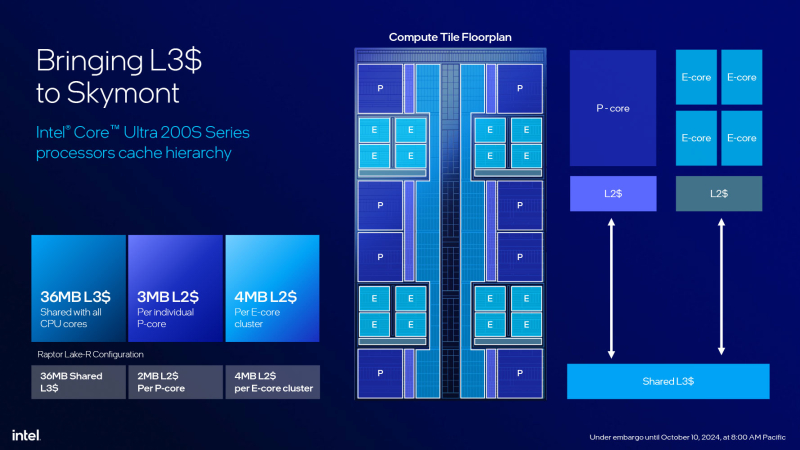
Unlike previous generations of Raptor Lake-S and Alder Lake-S processors, the new Arrow Lake-S has high-performance P-cores and energy-efficient E-cores that are not grouped together. The large and small cores of the Core Ultra 200S processors are arranged alternately: a row of P-cores is followed by a cluster of E-cores, followed by two rows of P-cores, and then another cluster of E-cores before the last row of P-cores. The end result is a configuration of eight P-cores and 16 E-cores. This core layout reduces heat concentration when the P-cores are loaded (for example, during gaming) and ensures that each E-core cluster is just one hop away from the ring bus and away from the P-core, which should improve thread migration latency.
Each E-core cluster (four cores each) received 4 MB of L2 cache. Each P-core is allocated 3 MB of L2 cache memory, which brings it to a total volume of 40 MB. The amount of second-level cache memory has not changed compared to the previous generation and is 36 MB. The L3 cache is shared among all P and E cores. The new design of Arrow Lake-S processors clearly shows that it is aimed at reducing power consumption.
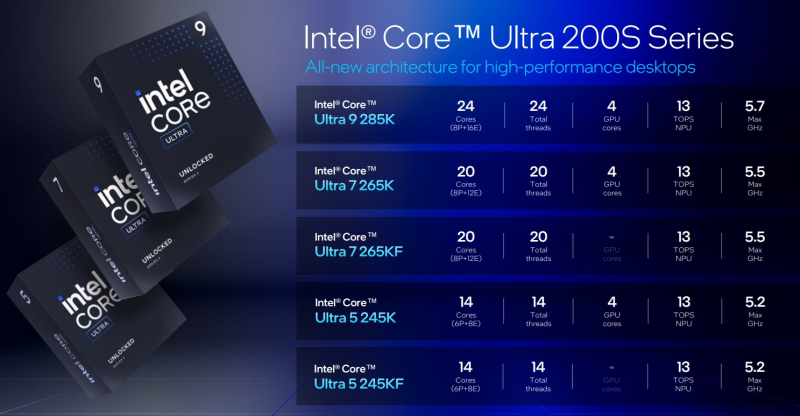
Intel has released five models of Core Ultra 200S processors: Core Ultra 9 285K, Core Ultra 7 265K, Core Ultra 7 265KF, Core Ultra 5 245K and Core Ultra 5 245KF. KF models are distinguished by the absence of integrated graphics. All new products are equipped with an AI accelerator (NPU) with a performance of 13 TOPS (trillion operations per second). It does not help with games, but is intended to speed up the operation of some AI functions included in Windows 11.
The flagship model Core Ultra 9 285K has 8 P-cores and 16 E-cores with support for 24 threads, 40 MB of L2 cache and 36 MB of L3 cache. The maximum frequency of the P-cores of the new product is 5.7 GHz. With all cores running simultaneously, the processor can run at 5.4 GHz, which is 500 MHz lower than the Core i9-14900KS. The maximum frequency of the new E-cores of the Arrow Lake-S chip is 4.6 GHz. The Core Ultra 7 265K/7 265 KF models each received 20 cores with support for 20 threads (8P + 12E cores) with a maximum frequency of 5.5 GHz. They have 36 MB of L2 cache and 30 MB of L3 cache. The base frequencies of the P and E cores are 3.9 and 3.3 GHz, respectively, the maximum frequency on all cores at the same time is 5.4 and 4.6 GHz, respectively. Finally, the Core Ultra 5 245K/5 245KF models each received 14 cores with support for 14 threads (6P + 8E), have a maximum P-core frequency of 5.2 GHz (5.0 GHz on all cores simultaneously), 26 MB of L2 cache memory and 24 MB of L3 cache.
According to Intel, Arrow Lake-S, compared to its predecessors, provides a 19% increase in multi-threaded performance while using up to 58% less energy during operation. In practice, in work applications and benchmarks, the Core Ultra 200S demonstrates good, but less than we would like, single-core and multi-core efficiency.
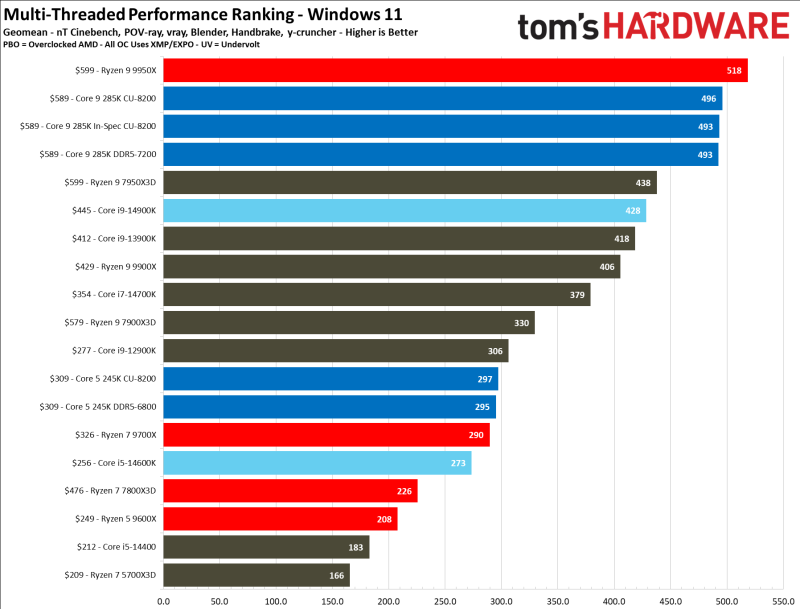
Despite the fact that Intel did the unthinkable and refused to support Hyper-Threading technology in its new chips, the multi-threaded performance of the flagship Core Ultra 9 285K has increased compared to its predecessor. In terms of single-threaded performance, the new chip is also faster.
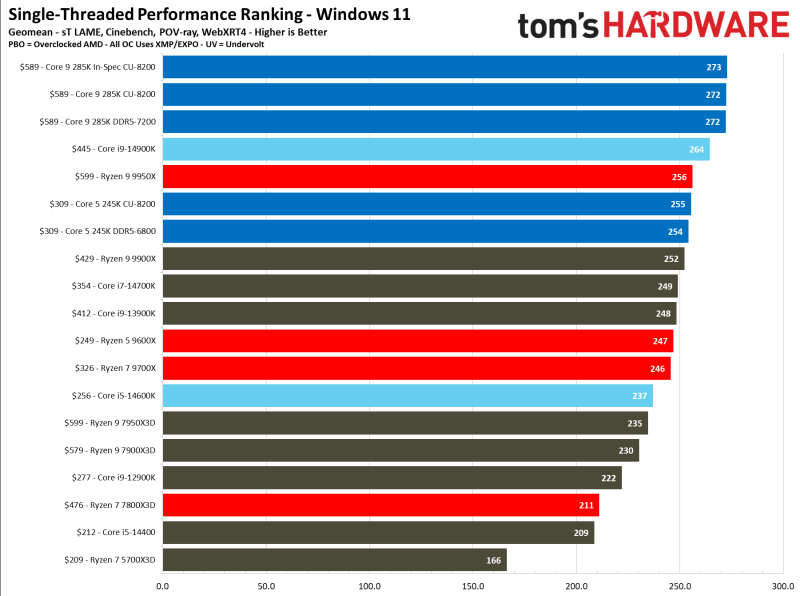
However, as Tom’s Hardware notes, the new flagship Core Ultra 9 285K is up to 4% slower in multi-threaded workloads compared to the AMD Ryzen 9 9950X. And this difference in performance in some applications is due to the fact that Intel abandoned support for AVX-512 instructions in new chips, while AMD chips support them.
It is somewhat difficult to describe the situation with the performance of new processors in games. On the one hand, this is a complete failure. The new series of Intel processors are indeed slower than their predecessors and competitors in games. On the other hand, the power consumption of new chips is significantly less.
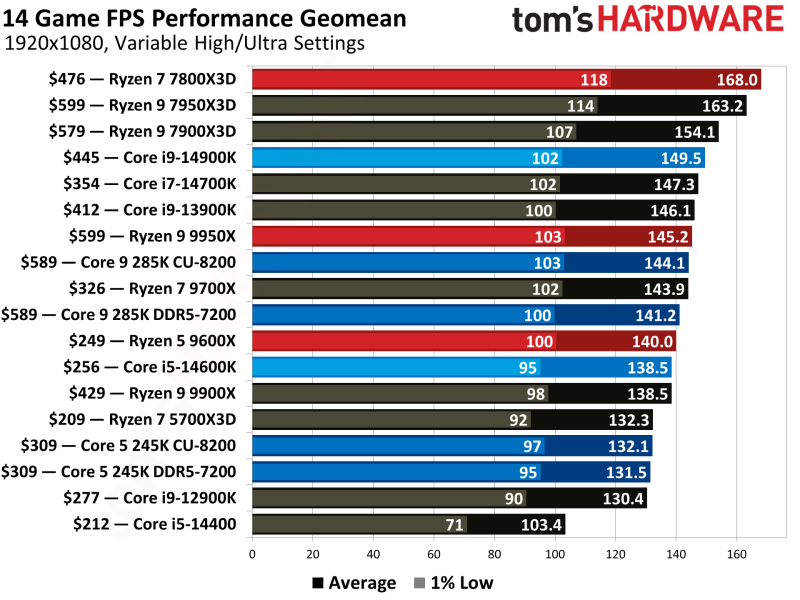
According to the Chinese publication MyDrivers, the Core Ultra 9 285K is inferior in performance to the Ryzen 7 9700X in games. It was also slower than the Core i7-14700K by a 2% difference. The Core Ultra 5 245K disappointed even more with its performance in games. It turned out to be the weakest chip based on 14 gaming tests and is 2% slower than the Ryzen 7 7600X.
A similar picture is described by the TechPowerUp portal, which also had a Core Ultra 7 265K model on hand for testing. According to the publication, the overall performance of the Core Ultra 9 285K is 1.2% higher than that of the Core i9-14900K. The Ryzen 9 9950X outperforms the new product by 3.4%. In some productivity tests, the Core Ultra 285K is significantly inferior to its competitors. Gaming performance results vary by game. For example, in some he takes the lead (example Spider-Man), in others he ends up at the bottom of the list (example Elden Ring). Compared to the Core i9-14900K, the new chip is on average 5% slower in 1080p games and 1.5% slower in 4K games.
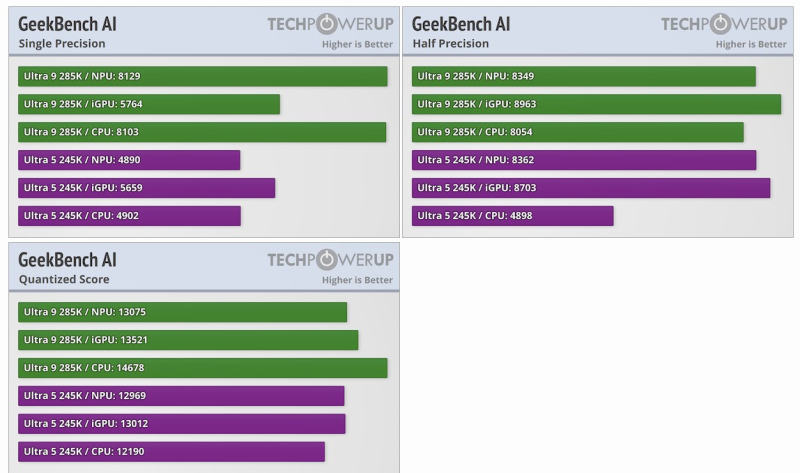
NPU performance
The productivity performance of the Core Ultra 7 265K is 3% better than the Core i7-14700K. The flagship Core Ultra 9 285K is only 7% faster. For workloads, the Core Ultra 265K is up to 27% faster than the Ryzen 7 9700X, which is quite impressive. It also outperformed the Ryzen 9 7900X and Ryzen 9 9900X. In 1080p gaming, the new Core Ultra 7 265K is about 6% slower than the Core i7-14700K. At 4K resolution the difference is 1.5%, not in favor of the new processor. AMD Zen 5 chips offer slightly higher performance.
Finally, the Core Ultra 245K turned out to be faster in work tasks than the once flagship Core i9-12900K. It’s also faster than the AMD Ryzen 7 9700X. Against the Core i5-14600K, the new chip has a performance advantage of 2.4%. In 1080p gaming, the new Core Ultra 5 245K is on average 4% slower than its predecessor, the Core i5-14600K, and up to 1% slower at 4K.
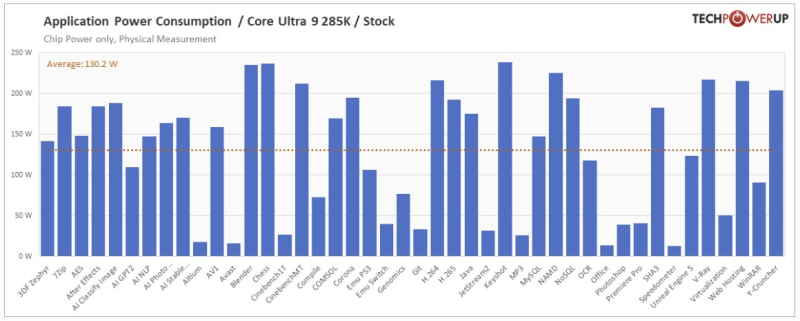
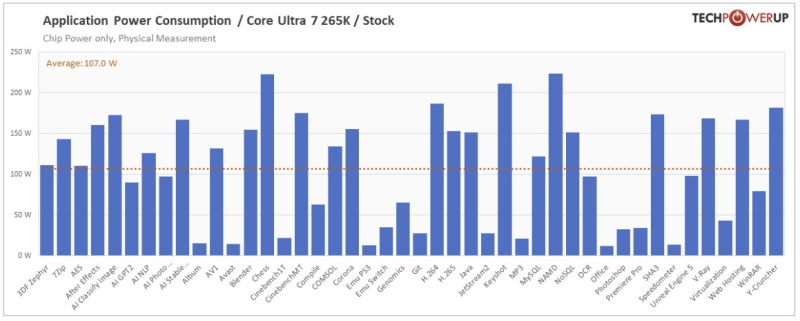

According to MyDrivers, power consumption in idle mode (Idle) of the new chips is also lower than that of competitors and predecessors. If the same Ryzen 7 7800X3D required 29 W when idle (CPU load 2%), then the Core Ultra 5 245K (CPU load 4%) required 11 W, and the Core Ultra 9 285K (CPU load 5%) required 11 W. 5 W. TechPoweUp confirms these findings, but its numbers are slightly higher than those of its Chinese counterparts, as can be seen in the graphs above.
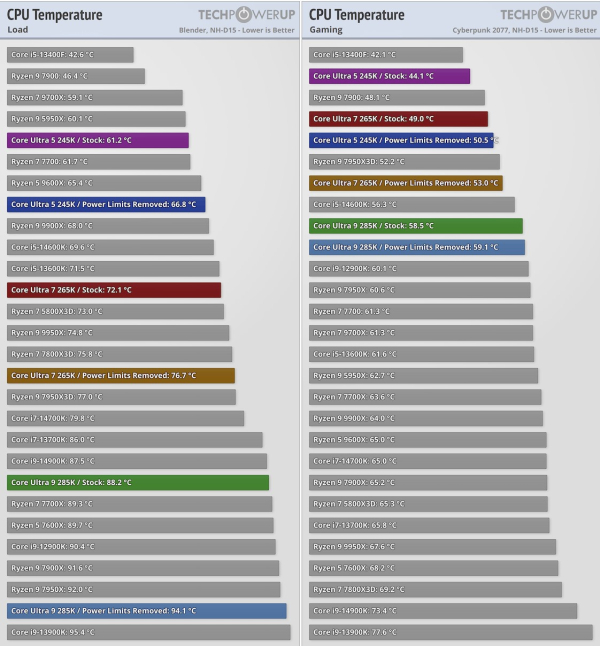
Temperatures in applications and games
According to MyDrivers, with standard BIOS settings in stress tests, Core Ultra 200S processors still consume a lot of power and get very hot. As part of the four-minute AIDA64 stress test, the large P-cores of the Core Ultra 9 285K processor ran at 1.276 V at 5.3 GHz (E-cores ran at 4.6 GHz). The total power consumption of the chip was 326 W, and the temperature of the large cores reached 99 degrees Celsius, despite the use of the efficient MSI MAG CORELIQUID I360 liquid cooling system. In turn, the Core Ultra 5 245K with standard BIOS settings in the same stress test heated up to 75 degrees Celsius, and its power consumption was 150 W. The P-cores of the chip operated at a voltage of 1.16 V and at a frequency of 5.0 GHz.
By changing the BIOS settings and reducing the voltage of the P- and E-cores of the Core Ultra 9 285K by 0.15 V, the large processor cores operated at 1.1 V. As a result, the chip’s power consumption dropped from 326 to 222 W (104 W less). The temperature of the cores dropped from 99 to 80 degrees Celsius. The Core Ultra 5 245K managed to reduce the voltage of the P- and E-cores of the Core Ultra 5 245K by 0.1 V. As a result, the maximum power consumption of the chip dropped to 132 W, and the temperature dropped to 67 degrees Celsius.
In games, even with standard BIOS settings, the temperature of the Core Ultra 200S processors turned out to be more than acceptable. According to TechPowerUp, the Core Ultra 5 245K warmed up to just 44.1 degrees Celsius, the Core Ultra 7 265K model reached 49 degrees, and the flagship Core Ultra 9 285K reached 58.5. When the power limit was removed, the temperature of the first increased to 50.5 degrees, the second – to 53 degrees, and the third – to 59.1 degrees. In workloads, the Core Ultra 9 285K temperature was 88.5 degrees Celsius, according to tests by the same TechPowerUp. The Core Ultra 7 265K has 72.1 degrees (76 degrees with the power limit removed), and the Core Ultra 5 245K has 61.2 degrees (66.8 degrees with the power limit removed).
The new Core Ultra 200S chips turned out to be very strange indeed. As reviewers note, on the one hand, they offer a slight but increase in productive performance, increased energy efficiency, support for a new type of CUDIMM memory, reduced cooling requirements and more headroom for overclocking RAM. The disadvantages of new chips include their cost and general degradation of gaming performance.